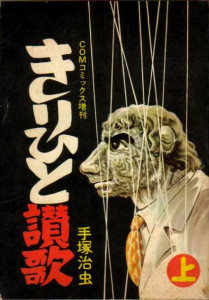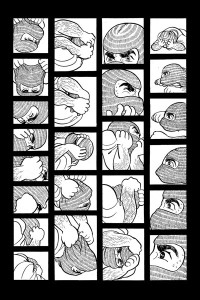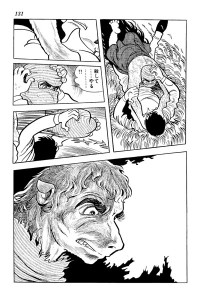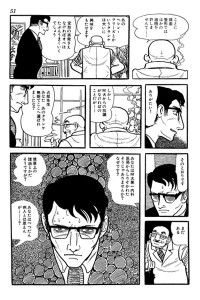Ode to Kirihito (Manga)
Also known as きりひと讃歌 (Kirihito Sanka)
| English Title: | Ode to Kirihito |
| In English? | Yes |
| Japanese Title: | きりひと讃歌 Kirihito Sanka |
| Type: | Ongoing Serial |
| Original run: | 1970/04 – 1971/12 |
| Published in: | Big Comic ビッグコミック |
| Published by: | Shogakukan |
| Volumes: | 4 MT-031 | MT-032 MT-033 | MT-034 |
Ode to Kirihito (1970-71), originally serialized in Big Comic from April 1970 to December 1971, is part of Tezuka’s general shift in the late 1960’s/early 1970’s towards more mature subject matter. It is also Tezuka’s first step into a genre he would later master with Black Jack (1973-83) and A Tree in the Sun (1981-86) – the medical drama.
What it’s about
The story opens with the two doctors of “M” University investigating a rare incurable disease found only in the remote village of Inugamisawa – a pun on the Japanese word for “dog”, Inu (犬). The disease, known as ‘Monmow’, causes the bones of the body shrink and enlarge in strange proportions, making the body of the sufferer twist into a dog-like shape before death. Dr. Tatsugaura, who plans to publish his virus-based theory of Monmow and use it as leverage in order to win the presidential election of the Japan Medical Association (JMA), seeks to eliminate his key rival, Dr. Osanai, a member of the Young Doctors’ Association. To this end, he sends Dr. Osanai to do an on-site study of Inugamizawa, where he is sure to contract the dreaded disease. Things go according to Tatsugaura’s nefarious plans, Dr. Osanai is confined within the village, gives up on his engagement to Izumi and marries a village girl named Tazu to gain acceptance and keep him safe from the wrath of the village, and does indeed contract the dreaded Monmow.
Although Osanai, with Tazu’s help, eventually discovers that Monmow is caused by chemicals seeping into local the river water and is able to stop the disease from progressing, he is unable to find a cure that will reverse the effects. When Tazu is murdered by a rapist, he decides to leave the village and goes on a journey of self-discovery which leads him to Taiwan and eventually sees him accept his fate as a doctor with the face of a dog and settle in a remote town in the Syrian desert.
Meanwhile, back in Japan, Tatsugaura’s schemes have steadily been coming to fruition. With his disappearance, Tatsugaura orders Osanai’s name to be deleted from the registry of the doctors at “M” University. At a medical conference he presents his theory that Monmow is caused by a virus. However, Urabe, one of Osanai’s colleagues, brings the South African nun, Sister Helen, to the same conference and explains that she has contracted Monmow by drinking contaminated water – a revelation which supports Osanai’s theory that the cause of Monmow is endemic rather than viral.
Despite this, and Osanai making a dramatic appearance and exposing his misdeeds, Tatsugaura wins the JMA presidential election. However fate takes a hand and Tatsugaura contracts Monmow. Foolishly holding fast to his virus theory, despite considerable evidence to the contrary, Tatsugaura eventually slips into a coma and succumbs to the disease. In the end, Helen gives birth to Urabe’s healthy, non-deformed baby, and Osanai (still with his dog-like appearance) returns to Syria to fulfill the promise to return he made to the Arab villagers. Izumi decides to follow him and their future together is left uncertain.
What you should know
In Ode to Kirihito (1970-71), Tezuka explores themes ranging from medical corruption, the contrast between traditional rural life and that of the modern urban world, and the transformation of the individual through suffering. Indeed as Tezuka himself says in the afterword to the Osamu Tezuka Complete Manga Works edition (MT-034), “whenever the story background is about medical issues, you just can’t get away from power, authority and position issues. You are really tied to that kind of feudal system” (1977, p. 243).
Another major theme presented in Ode to Kirihito (1970-71) is that of a wandering journey of self-discovery. Speaking to that, in an interview published in Osamu Tezuka’s Choices Episodes, Tezuka says “Novelists often say… their characters get out of hand, and this happens with manga too. When I was writing… Ode to Kirihito… [Osanai] then started to wander on his own. Originally I planned to have everything happen in a smaller circle, but the story came to have an unexpected turn as many characters joined the scene, and I finally gave up and let the hero act out his own story. But it turned out that he successfully resolved the subplots one after another, and led the story to a denouement” (1990, p. 24-26).
As part of his transition period towards darker, more in-depth thematic exploration and experimental graphic design, Tezuka received a fair amount of push back from his editorial staff when Ode to Kirihito (1970-71) as first published. By having yet another “wolf-man” character type, the initial reaction was that it might be perceived as a rehash of his manga series Vampires (1966-69). The main concern being that Osanai’s “dog-face” would disrupt the realistic nature of the work and turn it into a fantasy-based manga for kids. As such, Tezuka was advised to change Osanai’s face back to normal as soon as possible. However, luckily, in keeping with his reoccurring exploration of the theme of “transformation”, Tezuka felt it would be a good idea to have the main character stand out in some way and declined to make the change.
Ode to Kirihito (1970-71) also presented Tezuka with somewhat of a technical challenge. Although he’d received his MD, his medical school days were long behind him. So, when it came time to describe medical treatments and procedures in detail, he found it difficult to present them accurately enough to satisfy his own demanding standards – as well as those of his nit-picky fans. As such, he relied on help from former schoolmates and other medical colleagues to get it right – something that would serve him well a few years later when he began to work on his popular medical-based manga, Black Jack (1973-83).
Where you can get it
Luckily, for English-speaking fans, Ode to Kirihito was published by Vertical Inc. in 2006. Originally released as a single trade paperback volume, notable for having an unusual cover design by Chip Kidd which features a slider that, when moved to the right shows Osanai’s normal face, and when moved to the left, reveals Osanai’s face after he has contracted Monmow disease. Subsequently, in 2010, Vertical Inc. republished Ode to Kirihito in two separate volumes with no slider, but with each volume using one of the faces on the cover.






